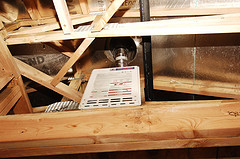Water On-Demand-Heater
Making Better Use of Stored Water
As opposed to the on-demand-heater, most people have the conventional type water-heating-system. This large tank, usually found in our basements, holds stored water and the water is kept heated by gas or electricity.
<
This results in what is referred to as "stand-by loss", as the regular tank has to heat the water after it cools.
The on-demand-heater is much more energy efficient.
The hot water flow is constant. The heater heats the water as it flows through a heat exchanger coil. Instead of heating water ahead of time, water is heated only when needed and as it passes through the system. This is an instant process.
The tankless-water-heater, as it is also referred to saves money, energy and water because there is no such thing as running water for any length of time while waiting for it to get hotter.
It shuts down until it is needed next time. Again, it's an energy saver, because no water is left in any pipes once the water shuts off unlike the conventional tank which is located centrally.
This just might be a very desirable feature to consider when building or purchasing your next home.

These units take up alot less physical space as well rather than a standard tank, and are usually a wall mounted device.
They install rather quickly and easily, requiring a few basic plumbing procedures.
Extremely popular throughout Europe and Asia, these types of heaters are becoming increasingly popular in North America.
A tankless-water-heater would be typical for use in most of the house, coupled with a "point of use" heater, meaning water is available immediately at the spot it would be used.
Electrical units are costly to run, and would depend greatly upon the layout of the rooms in your house, hydro costs in your area, and how much hot water really would get used. Gas and propane can be used to run the systems as well though.
A homeowner can save possibly up to 50% on their water heating section of a gas bill, though the unit costs initially to install.
These systems can cost anywhere from five hundred to fifteen hundred dollars to purchase.
Certain instant-on water heaters can be used with a solar preheating system, providing even more energy savings over time.
Leave On-Demand-Heater
Return To Cut Hydro Costs
Return To Carbon Footprint Defined Home Page

Thanks For Your Support
Green Maven!

Popular Tips
Recycling Tips
Garage Sale Tips
Laundry Room
Green Travel
The Company Money
Eco-Baby Gift
Make A Diaper Cake







